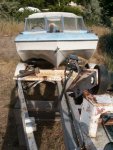Re: trihull design
The pounding is a generalization that is untrue of all tri-hulls. The individual differences from manufacturer to manufacturer varies widely. Some tri-hulls had shallow deadrise at the transom, and were little more than flat hulls with exagerated chines. Others had very deep deadrise, and the outer sponsons barely even touched the water when on plane, giving a ride very similar to a standard deep V hull. My tri-hull for example has almost 23 degrees deadrise at the transom, and that continues to the bow, where it gets even steeper. When on plane, I rarely catch air, and it cruises through chop like it isn't there. It leans quite hard in sharp turns, and like a deep V hull, does not jump on plane immediatly but takes a few seconds and 2/3rds throttle. In effect, its like a deep V hull with a lot more room in the bow. At low speeds and at rest, it is very stable, I can walk all over the front and there is no dramatic tipping or "tenderness". Low speeds and rest position is the only time the outer sponsons are touching the water. in effect my particular hull design has the best of both worlds. The only current boat I can think of with a similar hull design is the Hurricane Fundeck, and it got great revues when tested. If person was actually looking for a tri-hull, they should look for a lot of deadrise. the other consequence is they can be heavier as well, but the stability makes it worth it.


























